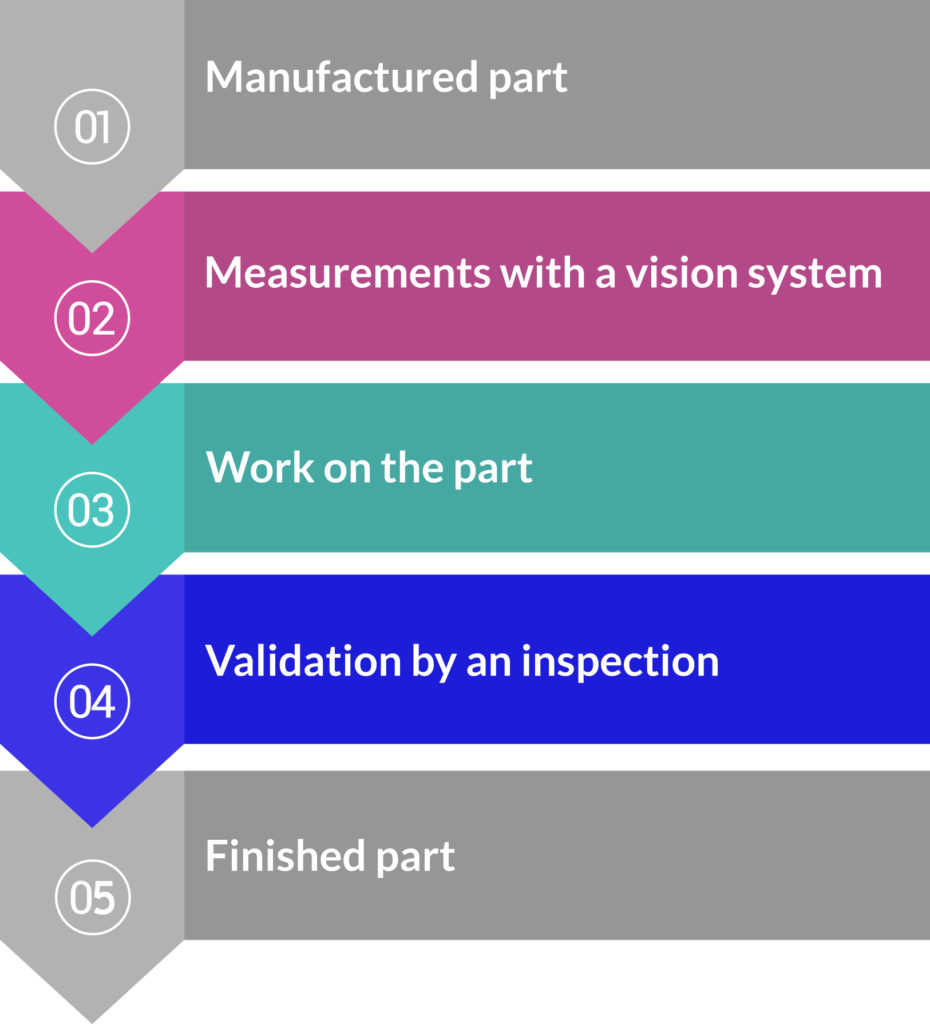
The aerospace industry is a high technology sector, especially in the jet engines production. The market is in constant evolution. In the past years, the industry’s key players pressured the manufacturers to improve their engines by increasing fuel efficiency, reducing noise and by being more efficient. To obtain these results, jet engines manufacturers have needed to increase their standards. One of the main methods implemented to achieve these goals was to improve aerodynamics on blades and vanes by using tighter tolerances and more complex elliptical 3D profiles.
Jet engines manufacturing factories have, up until a few years ago, finished the surface of their parts manually. In some plants, you could come upon automated systems to do this process, but these were “blind” systems, meaning that the automation is led by a fixed program. These “blind” automated solutions are still valid for some processes. However, with the industry’s new requirements calling for aerodynamic improvements on critical parts such as blades and vanes, these methods no longer applied. To ensure reaching tighter tolerances with a high level of precision, jet engines manufacturers had no choice but to upgrade their work processes.
This reality created a new challenge for innovative companies to step up their game and develop innovative automated solutions able to reach the new requirements. Hence, robotic specialists came up with adaptive automated solutions.
What is an adaptive automated solution?
Most of the time, basic automated systems use robots. These are repeatable, but not really accurate. To overcome this lack of accuracy, an adaptive process needs to be implemented. Adaptive means that the system is able to measure and adapt its process in real-time.
Let’s apply this method to a blade finishing process: first, a vision system takes measurements of critical features of the blade to ascertain its geometry. This first step is primordial because often input parts dimensions vary a lot more than required tolerances. With the exact part dimension and geometry, the adaptive system can then compute finishing parameters to get the part from its unique original shape to the precise result. When the process is done, the part is inspected again to ensure it is within tolerances. Therefore, adaptive technology is necessary to guarantee that each part respects the tight requirements.

What are adaptive benefits for a manufacturer?
Obvious benefits from adaptive automation are improvement of production’s quality and consistency, reduction of abrasive consumption and therefore its cost, better ergonomics and safety and more stable throughput.
Furthermore, since real adaptive systems consider parts variations, the parts can be less precise before they enter the automated system and still get through quality afterwards. This means that the manufacturing process is no longer required to be as precise. The micron tolerances will be reached at the end of the process by the adaptive automated system.
Some aerospace manufacturers also use measurements collected from an adaptive solution for other purposes. Pioneering factories even exploit this data to replace ceramic coating thickness measurement or elliptical profile inspection.
When is an adaptive solution necessary?

When your production process is not fairly constant and you feel its impact on the final tolerances, an adaptive automated system will be highly recommended to execute the task.
Also, it is obvious that the Aerospace’s Maintenance Repair and Overhaul (MRO) market is directly concerned by this technology. In a world where each part is quite different since it has been used in a jet engine, the measurements took by the vision system at the beginning of the process are crucial to perform the work and to reach the final tolerances. For more details on the development of an adaptive automated system for the MRO, look up this case study.
How to successfully implement an adaptive solution?
At the beginning of a project, the manufacturer and its automation supplier need to clarify what are their interpretations of part variations and of an adaptive technology. It is also important to determine which process will need to use an adaptive system. The adaptive solution could be specific for every process. Moreover, there are different levels of adaptive complexity which often lead to misunderstanding. Some applications only require basic adaptive solutions and other need more complex ones; refer to the chart hereunder to view examples of adaptive complexity levels.

It is crucial to establish the real automation needs at the beginning of the discussions. If all the requirements are clear and understood by both parties at the kickoff of the project, success is foreseeable!
You will learn more about the misunderstandings about adaptive technology by reading our next blog on different technologies commonly mistook for adaptive (closed-loop, force feedback, compliance, etc.). Even though these technologies can be part of the solution, they cannot be self-sufficient to generate an adaptive system. Stay tuned!